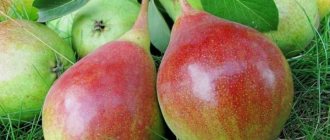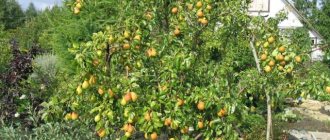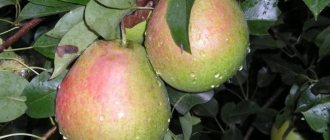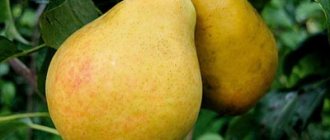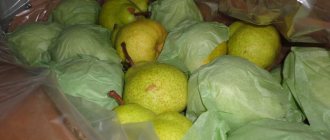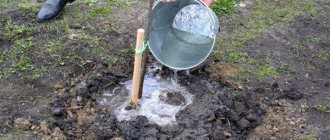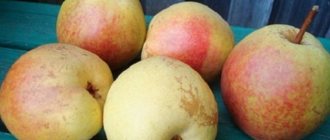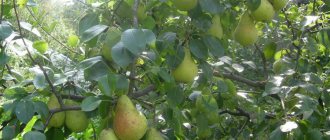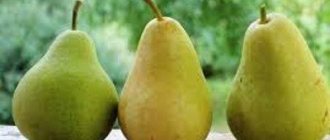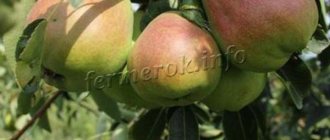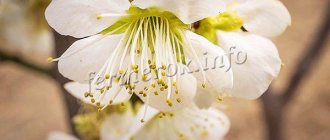Gardening » Pear
0
1240
Article rating
Kira Stoletova
Pear Tatyana is a high-quality hybrid bred at a horticulture station in the Voronezh region. The hybrid is mainly grown in its homeland and in the Rostov region.
Description of pear Tatyana
Description of the variety
Pear Tatyana belongs to the early autumn varieties. Since 1999, the variety has been included in the State Register and recommended for cultivation in the North Caucasus.
Characteristics of wood
Trees of this variety have medium growth vigor. The crown is compact, slightly thickened, and has a narrow pyramidal shape. After the start of fruiting, the crown of the tree becomes more spreading and acquires a spherical or wide pyramidal shape.
The trunk is covered with smooth dark gray bark. On skeletal branches, the bark has a gray-brown tint. The leaves are large, green, broadly ovate in shape. The surface of the leaf plate is smooth, with a characteristic shine.
Pear tree Tatyana.
Description of fruits
The pears are medium in size. The weight of one fruit is about 150 grams. Individual specimens can reach 230 grams. The pear shape is standard.
The main color of ripe fruits is golden yellow. Most of the surface of the pear is covered with a blurred, red-brown blush. The fruits are also covered with many small subcutaneous punctures.
Pears have a delicate, dessert, sweet and sour taste. The pulp of the fruit is very juicy.
The harvest takes place in the first half of September. The shelf life of harvested pears is 2.5-3 months.
Characteristics
- Tatyana begins to bear fruit 7 - 8 years after planting as an annual seedling, which indicates late early fruiting;
- autumn variety. In the south of the Voronezh region, the ripening period is average. Harvesting maturity occurs in the first half of September. The period of pear consumption lasts until November-December, for 80 - 90 days;
- flowering occurs somewhat later than other pear varieties growing in the recommended growing zone, so return frosts do not threaten the flowers;
- According to the State Register, the average yield over the years of state testing (1995 - 1998) was 113 c/ha, which is almost 2 times higher than the control variety. According to other data, the yield during the first fruiting period is 144 c/ha, and subsequently increases to 154 c/ha;
- fruiting is annual;
- ripe pears do not fall off;
- Tatyana has good immunity. The crop is especially resistant to scab and is weakly affected by powdery mildew;
- winter hardiness in the recommended growing zone is very high. In the winter of 1986 - 1987, when thermometers recorded -34°C, freezing of tissues was very weak - up to 1 point. But in the Ryazan region, winter hardiness is no longer so high; without insulation, young trees may die;
- the harvested crop tolerates transportation well;
- subject to storage conditions, the fruits can last until February;
- method of use is universal. Compotes from this pear are especially good; their quality is rated 4.6 points.
Reviews
The pear tree has grown quite tall, but its crown is narrow and the tree is quite compactly located in the garden. We had to wait a long time for the first harvest, but the quality of the harvested fruits was simply excellent
Peter
Bataysk
The fruits on Tatyana are not one-dimensional, but there are very few small specimens. Pears taste very good, so we leave most of the fruits fresh and store them in the cellar.
Irina
Stavropol
The tree of this variety is quite tall, but it is not difficult to care for. The pear rarely gets sick and does not need special care. To harvest from it, you will need a stepladder and a special fruit picker.
Lyudmila
Vladikavkaz
Planting and care
You can plant a pear in spring and autumn , but most gardeners prefer spring , since during the growing season the seedling has time to take root and prepare for the coming winter.
In order for our variety to show all its capabilities to the fullest, it is very important to choose the most suitable place for planting it.
The Tatyana variety is a vigorous tree and for its full development it requires a well-lit, free place without close proximity to other plants and buildings. Believe me, the pear is worthy of a royal position in your garden.
Lyubimitsa Yakovleva, Noyabrskaya, and Orlovskaya beauty are also strong-growing.
If you decide to plant several pear trees, you can arrange them in a row with an interval of 3-4 meters.
The pear tree does not tolerate flooding, and if it is possible, plants should be planted on artificial ridges or hills, and drainage grooves are needed to drain excess water.
Planting holes for pears should be no smaller than 1 meter and in diameter - 80 by 80 centimeters. The upper fertile layer is deposited separately from the less fertile one; when digging a planting hole, a roller must be made from the less fertile soil along the edge of the tree trunk circle to prevent water from spreading when watering.
The soil should be enriched with a large bucket of humus, two handfuls of superphosphate, a handful of potassium salts and a shovel of wood ash per seedling.
Pear grows well in slightly acidic soils and does not require liming of the soil. A mound is built in the middle of the planting hole, and the roots are evenly distributed along its slopes.
The mound must be well compacted, and when the roots are covered with soil, it is constantly compacted so that there are no voids , due to which the roots rot and the plant may die.
A peg is driven in next to the seedling, and our plant is loosely tied to it. The seedling is watered abundantly and the soil is mulched.
It should be noted that the younger the seedling, the faster and more painlessly rooting occurs; the best planting material is one- and two-year-old seedlings.
When planting annual plants, the top should be shortened to a meter, and the buds located below 50 centimeters should be removed; biennial seedlings have fairly developed shoots, and the pear is prone to self-forming crowns; pruning is done only for sanitary purposes.
In the event that freezing occurs and the pear grows tops, some of them are left to replace the affected shoots, but they will bear fruit only if they are placed horizontally, tied to pegs.
Watering and weeding in the first year of life are carried out regularly as needed; fertilizing is not needed - organic matter is added once every three years; enough minerals are added to the soil during planting for several years.
A lack of nutrients is easily determined when the growth of young shoots slows down; if their growth proceeds normally, no additional feeding is required.
An excess of organic matter leads to excessive growth of shoots, which, as a rule, do not have time to ripen by winter, and an excess of mineral fertilizers leads to poisoning of the plant body.
In everything we need measure, or rather, scientifically based calculation.
Before fruiting begins, the tree trunk circle needs to be dug up, then grassed and the grass must be mowed regularly.
Landing
Pears of this variety are undemanding to soil and adapt well to different growing conditions. In the selection of articles below, you can find useful recommendations for planting seedlings of the Tatyana variety.
How to plant a pear tree correctly
At what distance to plant pears?
How to choose pear seedlings
How to replant a pear
Characteristics of pear Tatyana
The Tatyana pear variety has a number of positive characteristics:
- The fruits ripen in early autumn. From the first year of fruiting, the yield volumes are pleasantly surprising, but the plants are not early-bearing: they begin to bear fruit at 5-6 years of age.
- Pear has a wonderful dessert taste. It is used for winter preparations, added to baked goods, prepared desserts, marmalade and compotes. When raw, the fruits do not last long and often fall off, so the harvest is harvested 10-12 days before full ripening.
- The Tatyana variety pear calmly tolerates temperatures down to -30°C and survives the winter well, has high transportability and good presentation.
Description of the plant
The trees are tall but compact. The crown is sparse because the shoots are poorly formed. As the plant matures, the shape of the plant transforms from narrow pyramidal to more rounded.
The bark has a rich dark gray color, young shoots are brown, with a slight shade of purple. The leaves are quite large, with wavy edges, and have a rounded, slightly elongated shape. The surface is smooth and glossy.
Trees bloom quite late. The flowers are white and pink, forming an umbrella inflorescence.
The Tatyana pear variety is self-sterile. The best pollinating varieties for it are considered to be autumn pears Yakovleva and Bere Moskovskaya.
Description of fruits
The fruits can be medium or quite large. Their weight ranges between 150-250 g. Outwardly they are attractive: regular pear-shaped shape, rich color, beautiful glossy surface.
The skin is a rich golden yellow with a faint blush. Subcutaneous points are clearly visible. The pulp is creamy-white, juicy but tender, and has a characteristic pleasant aroma.
Care
The crown of trees of this variety requires regular pruning and shaping. Otherwise, standard agrotechnical measures are enough for the pear. By clicking on the links below, you can find detailed instructions and tips for growing Tatyana pears.
How to care for a pear Pruning a pear Pruning a columnar pear Treating a pear from diseases and pests Feeding a pear How to water a pear
Diseases and pests
The Tatyana variety has good resistance to fungal diseases. But, preventive measures are very important to maintain the plant’s immunity and health. The articles below contain a lot of useful information on this issue.
Dangerous Pear Pests
Pears often suffer from pests, they affect the leaves, bark and fruits.
In this article, we have selected 11 of the most harmful insects that harm pear trees, and also ways to destroy them.
Diseases of pear trees
To get what they cherish, gardeners have to work hard, and the reason for this is pear diseases.
Read about 19 common pear diseases and how to combat them.
Planting a pear Tatyana
The most important step is choosing a good seedling. It should not show any signs of disease or damage. The optimal time for planting this variety is considered to be the beginning of spring.
Selecting a location
Pear loves sunlight
The ideal planting site is a place with good sunlight and protected from drafts. It must be taken into account that the groundwater on it should be as low as possible. It is believed that for better plant growth, the selected area must be enriched in advance with organic matter with the addition of superphosphate.
Pit preparation
The diameter of the planting hole is 70-80 cm, and the depth is at least 90-100 cm. It is prepared in advance, preferably in the fall. If the area has not been fertilized, 2 buckets of humus mixed with a bucket of sand and soil with the addition of mineral fertilizers are added to the hole.
Planting
The seedling is lowered into the planting hole very carefully so as not to damage the root system. The roots are straightened, after which the tree is covered with soil, making sure that the root collar remains several centimeters above ground level.
After planting, the soil is compacted well and the plant is watered abundantly.
